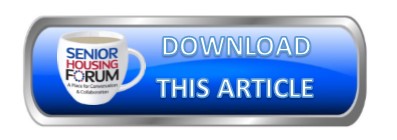Improve response times by up to 75%, compared to industry averages!
By Jane Kincaid
Real-time location systems, or RTLS, are used to identify and track the location of people or assets in an indoor or designated location. First used by government and military agencies, RTLS has evolved to become more commonly used in health care, including long-term and post-acute care. With a number of benefits that span resident safety and care, RTLS can play a key role in enhancing care in the senior care environment.
An RTLS uses receivers (aka sensors or transmitters) that send wireless signals from “tags” attached to an individual or asset, such as a wheelchair. This communication determines where the tagged individuals/assets are in the care center environment. The RTLS device collects data that is then viewable on a computer software system.
Senior Care Settings
In the senior care environment, RTLS is commonly known for helping to ensure the safety of residents by tracking their movements. This can be especially helpful for facilities that care for individuals with Alzheimer’s disease or other dementias. The system can pinpoint the location of a resident who may have walked away from a designated area. The RTLS device then sends that information to staff in real time. The result is a more coordinated monitoring system to better meet care needs.
One application that uses real-time location is iNFORM, a wireless or wired nurse call system from Cornell Communications, a Senior Housing Forum partner. iNFORM is a nurse call system that features two-way communication and real-time data on staff productivity and resident care levels. It also runs on an easy-to-use iOS mobile device that can accommodate multiple applications.
The Advantages of RTLS
“By combining resident and staff communication systems into one, iNFORM can eliminate the need for multiple communication devices while adding tracking and reporting capabilities that enhance staff performance and resident satisfaction,” says JJ Johnson, founder and CEO of Cornell. JJ notes that he has seen the following improvements with clients using iNFORM:
-
Faster response times by up to 75 percent, compared to industry averages;
-
Reduced turnover by residents and staff;
-
Eliminated alarm noise for a more peaceful environment; and
-
Generated new revenue when increased ADL needs were reported.
“Cornell’s iNFORM mobile nurse call system is the modern nurse call solution for assisted living, skilled care, independent living, and medical outpatient facilities in need of an effective, affordable nurse call system,” says JJ.
In addition to helping respond to situations like the one described above, iNFORM and other RTLS devices can help paint a picture of a resident’s overall mobility. RTLS enables users to collect data on a resident’s walking distance, for example, which gives insight into their physical activity. In the same vein, an RTLS device can alert staff when a resident has not left their room for some time or is suddenly less mobile than usual.
Staff Alignment
RTLS systems can also be used to free up staff time and ensure appropriate care assignments. If a staff member needs help transporting a resident, for example, other nurses can be located immediately because the system provides their location in real time. As a result, staff members’ can be redirected if needed.
RTLS also has a time-stamping capability. Data obtained via the RTLS can be used to adjust staffing levels. This can be accomplished by assessing which tasks require the most staff support, and the data can help providers better align staff to resident needs by improving timeliness and quality of care.
RTLS tags can also be used on equipment to get a clear idea of the availability and location of items like beds, ventilator systems, wheelchairs, and more.
Other Wireless Tech
Other wireless sensors have shown promise in improving resident care. These sensors span a range of capabilities, from wearable devices and as a way to track heart and blood pressure rates. Sensors can also be placed on mattresses to track movement and restlessness during sleep. Yet another RTLS application is the use of motion sensors on doors to gauge resident (and staff) movement.
The iNFORM solution utilizes RTLS in a positive and effective manner, says JJ. “iNFORM notifies staff which resident needs assistance and what time they called. It also indicates the location of a resident and identifies which staff member took each call. The data is then used to tabulate both travel time and the time spent with each resident.”
As with any new initiative, cost and privacy factors can come into play when implementing new sensor technology in a senior care center. With the right approach and resources, care providers can make the most of real-time technology to meet the goals of responsive care, improved quality of care, better quality of life.
To learn more about the products and services available from Cornell Communication, call (800) 558.8957 and visit their website at:
Click on the button below to download a PDF copy of this article:











Trackbacks/Pingbacks